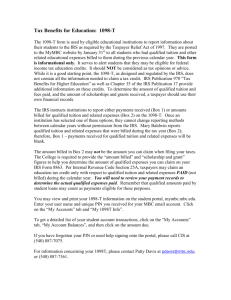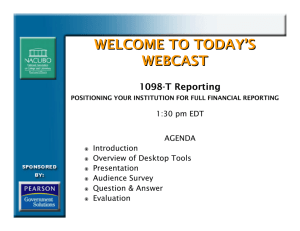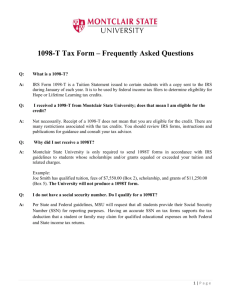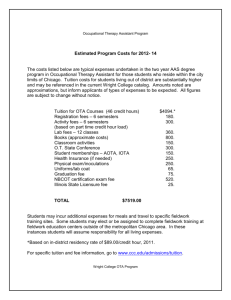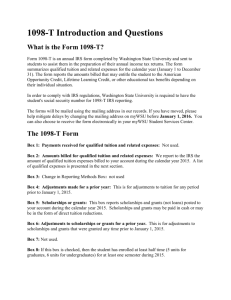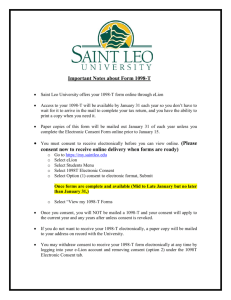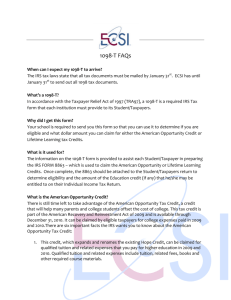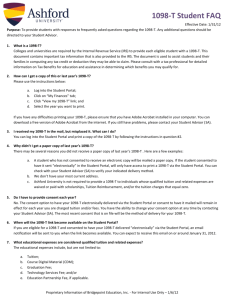Frequently Asked Questions About the 1098-T Tax Form
advertisement
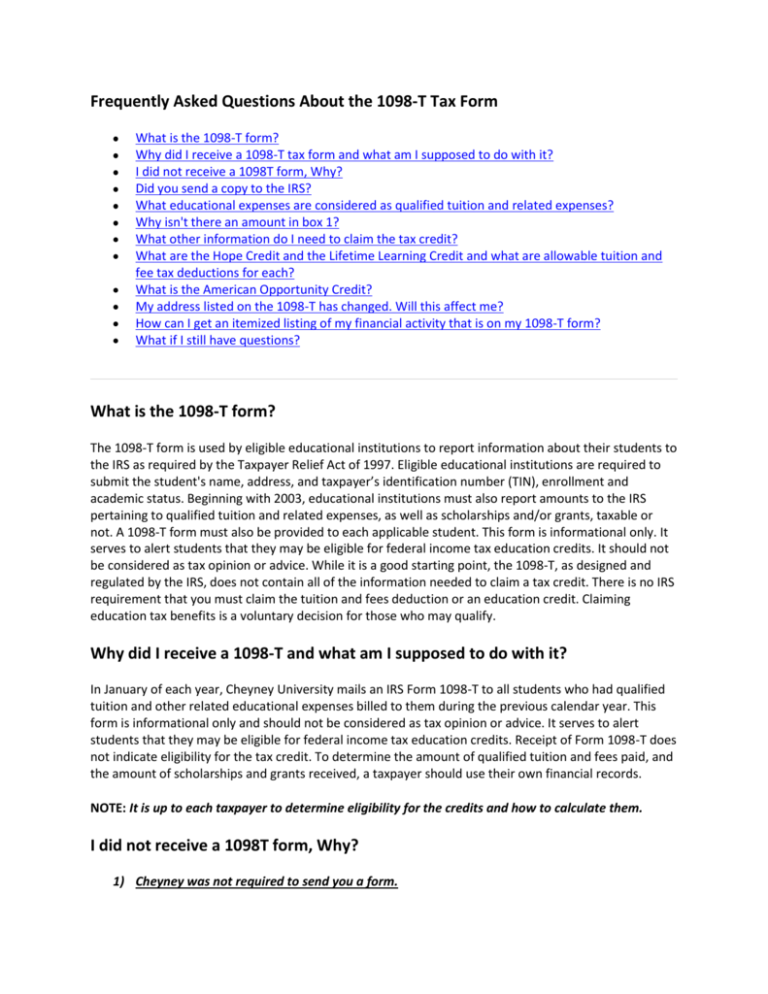
Frequently Asked Questions About the 1098-T Tax Form What is the 1098-T form? Why did I receive a 1098-T tax form and what am I supposed to do with it? I did not receive a 1098T form, Why? Did you send a copy to the IRS? What educational expenses are considered as qualified tuition and related expenses? Why isn't there an amount in box 1? What other information do I need to claim the tax credit? What are the Hope Credit and the Lifetime Learning Credit and what are allowable tuition and fee tax deductions for each? What is the American Opportunity Credit? My address listed on the 1098-T has changed. Will this affect me? How can I get an itemized listing of my financial activity that is on my 1098-T form? What if I still have questions? What is the 1098-T form? The 1098-T form is used by eligible educational institutions to report information about their students to the IRS as required by the Taxpayer Relief Act of 1997. Eligible educational institutions are required to submit the student's name, address, and taxpayer’s identification number (TIN), enrollment and academic status. Beginning with 2003, educational institutions must also report amounts to the IRS pertaining to qualified tuition and related expenses, as well as scholarships and/or grants, taxable or not. A 1098-T form must also be provided to each applicable student. This form is informational only. It serves to alert students that they may be eligible for federal income tax education credits. It should not be considered as tax opinion or advice. While it is a good starting point, the 1098-T, as designed and regulated by the IRS, does not contain all of the information needed to claim a tax credit. There is no IRS requirement that you must claim the tuition and fees deduction or an education credit. Claiming education tax benefits is a voluntary decision for those who may qualify. Why did I receive a 1098-T and what am I supposed to do with it? In January of each year, Cheyney University mails an IRS Form 1098-T to all students who had qualified tuition and other related educational expenses billed to them during the previous calendar year. This form is informational only and should not be considered as tax opinion or advice. It serves to alert students that they may be eligible for federal income tax education credits. Receipt of Form 1098-T does not indicate eligibility for the tax credit. To determine the amount of qualified tuition and fees paid, and the amount of scholarships and grants received, a taxpayer should use their own financial records. NOTE: It is up to each taxpayer to determine eligibility for the credits and how to calculate them. I did not receive a 1098T form, Why? 1) Cheyney was not required to send you a form. a. Cheyney University is only required to send 1098T forms to students whose qualified tuition and related expenses is greater than the students’ scholarships, grants and waivers. (Please refer to IRS instructions for Forms 1098E and 1098T page 2 under exceptions. http://www.irs.gov/pub/irs-pdf/i1098et_10.pdf ) As an example: i. Student A has qualified tuition and fees of $7,550 (Box 2) and scholarship, waivers and grants of $11,250 (Box 5) for calendar year 2010. Student A will not receive a 1098T form from the University. ii. Student B has qualified tuition and fees of $8,275 (Box 2) and scholarship, waivers and grants of $2,250 (Box 5) for calendar year 2010. Student B will receive a 1098T form from the University. 2) The address that the University has on record as of 12/31/10 is not your current address. a. Students should call the Bursar’s office to receive a duplicate copy of your 1098T form. b. Students will also be required to update their address with the Registrar’s office. Did you send a copy of this form to the IRS? Yes. Section 6050S of the Internal Revenue Code, as enacted by the Taxpayer Relief Act of 1997, requires institutions to file information returns to assist taxpayers and the Internal Revenue Service in determining eligibility for the Hope and Lifetime Learning education tax credits. Forms are mailed at the end of January of each year for the previous tax year. What educational expenses are considered as qualified tuition and related expenses? Qualified tuition and related expenses for calculating tax credits/deductions: Tuition fees required for enrollment or attendance at an eligible educational institution (any accredited public, nonprofit, or proprietary postsecondary institution—including Cheyney University) Books, supplies and equipment needed for a course of study Ineligible expenses for calculating tax credits/deductions: Room and board Athletics (unless the course is part of the degree program) Insurance Transportation Other similar personal, living or family expenses Included Graduate and Undergraduate Tuition All Tuition Related fees except Health Services Fee and Student Activities Fee Book Vouchers Not Included Health Services Fee Student Activities Fee Room Charges Board Charges Application fees Transcript fees Diploma fees Other Miscellaneous Fees For more information about qualified educational expenses please go to: http://www.irs.gov/publications/p17/ch35.html#d0e74760. Why isn't there an amount in box 1? The IRS instructs institutions to report either payments received (Box 1) or amounts billed for qualified tuition and related expenses (Box 2) on the 1098-T. Once an institution has selected one of these options, they cannot change reporting methods between calendar years without IRS permission. Cheyney reports qualified tuition and related expenses that were billed during the tax year (Box 2) and scholarships and grants, therefore, Box 1 – Payments Received for Qualified Tuition and Related Expenses, will be blank. What other information do I need to claim the tax credit? While it is a good starting point, the 1098-T, as designed and regulated by the IRS, does not contain all of the information needed to claim a tax credit. Most of the information needed must come from the student's personal financial records of what the student paid during the calendar year. Additionally, each taxpayer and his or her tax advisor must make the final determination of qualifying expenses. What are the Hope Credit and the Lifetime Learning Credit and what are allowable tuition and fee tax deductions for each? For an overview of the Hope Credit, Lifetime Learning Credit, and allowable tuition and fee tax deductions visit http://www.irs.gov/faqs/faq/0,,id=199791,00.html. Chapter 35 of IRS Publication 17 provides a very clear explanation of the eligibility requirements and filing instructions for the Hope Credit and the Lifetime Learning Credit. You can access an electronic copy of this chapter at http://www.irs.gov/publications/p17/ch35.html. Publication 17 includes a number of useful real-life examples. Publication 970 explains tax benefits for education: http://www.irs.gov/publications/p970/index.html. What is the American Opportunity Credit? For more information please visit http://www.irs.gov/publications/p17/ch35.html. My address listed on the 1098-T has changed. Will this affect me? No. The address shown on Form 1098-T is irrelevant for IRS income tax filing purposes. The single most important information on the form is your Social Security Number. Please note that we send your form 1098T to the address that the University has on record as of 12/31/2010. How do I get a reprint of my 1098-T form? If you did not receive a 1098-T due to a change of address, or you misplaced the form, please contact the Bursar’s office at 610-399-2224. How can I get an itemized listing of my financial activity that is on my 1098-T form? Calendar year account statements are available on Power CAMPUS self service. Please visit https://abtiq.cheyney.edu/selfservice/Home.aspx. What if I still have questions? If you have additional questions/concerns you can reach us by Phone: 610-399-2224 Note: Please be advised that Cheyney is prohibited from providing legal, tax, or accounting advice to students and we are not responsible for any use you make of this information.
